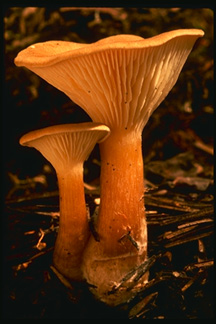Click on image for full size
Corel Photography
Kingdom Fungi
Though the outward appearance of many fungi may resemble plants, they are probably more closely related to animals. Fungi are not capable of performing photosynthesis, so must get their nourishment from other sources. Many fungi absorb organic matter directly from their immediate environment, such as in the soil. Many others feed on dead and decaying organisms and therefore have an important role in the recycling of nutrients in natural systems. Still others feed on living organisms. Athlete's foot is a common fungus which feeds on a living host - you!When you think of fungi, you probably think of the mushrooms we can buy at the supermarket or hunt for in the woods. However, those "mushrooms" are really just the "fruiting bodies" produced by the fungus for reproduction and represent only a very small part of a much larger organism which lives below the ground. Many species of soil-dwelling fungi, such as those that produce mushrooms, form intimate associations with tree roots and assist in absorbing nutrients from the environment in exchange for food from the tree. Biologists are just beginning to understand and appreciate the role of these "mycorrhizal" fungi in natural ecosystems.
Fungi come in a wide variety of sizes and forms, and many have great economic importance. Tiny, one-celled yeasts are important for baking breads and fermenting wines, beers and vinegars. The pharmaceutical industry relies heavily on several species of
fungi for the production of antibiotics, most notably, Penicillin, from a strain of Penicillium mold. If you leave your bread on the counter too long, you'll be able to observe a strain of the Penicillium mold for yourself!















